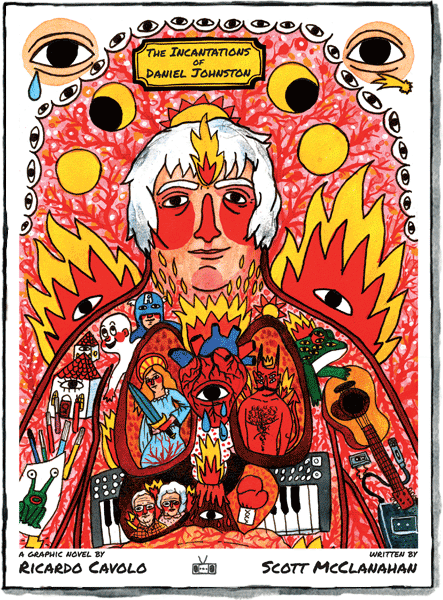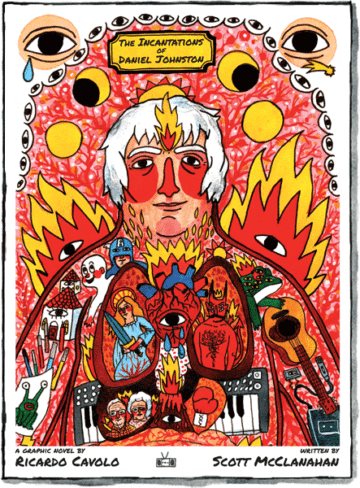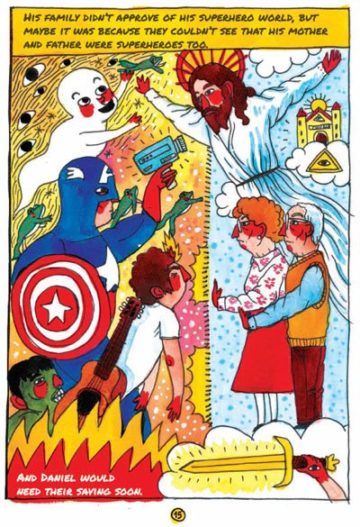
Graphic Novel Profiles Brilliant, Bipolar Daniel Johnston

Daniel Johnston performed just one song at the closing reception of an exhibit of his drawings in Austin earlier this year. The 55-year-old musician — creator of the “Hi, How Are You” frog commissioned in the 1990s by Austin’s Sound Exchange record store — looked frail and shaky. After singing “Rock This Town,” Johnston attempted to stand and almost collapsed. Two men caught him and helped him out of the Bale Creek Allen Gallery. “It’s typical,” said one fan of the brief performance. “He’s so messed up because he had electroshock therapy.”
Johnston’s mental health is as big a topic of discussion among his fans as his art. Ever since 1985, when Johnston first appeared on MTV and announced to a live audience that he had recorded his tape, “Hi, How Are You,” during a nervous breakdown, a certain lore has developed around the highs and lows of his bipolar disorder: He attacked friend and manager Randy Kemper with a lead pipe because he thought Kemper was possessed by the devil; threw the keys out of a plane in midair (both he and his father, the pilot, survived the crash); and rushed into an elderly woman’s apartment building to exorcise her demons, prompting her to jump out a second-story window.
The stories are incredible — and true — but Johnston’s deteriorating health put his and others’ lives at risk; after years of recording his lo-fi folk ballads in Austin, he moved back in with his parents in West Virginia, where he put on weight and his singing voice grew scratchy. Some said his strict regimen of meds stifled his artistic flow. It seemed that Johnston’s brief chance at fame had passed and he would never find the mainstream audience he so desired.
But interest in Johnston’s music and drawings — and more specifically, Johnston himself — resurged in the late ’90s, when he began to perform sporadically in public and made plans to record a new album. The release of the 2005 documentary, The Devil and Daniel Johnston, solidified Johnston’s comeback and popularized the mythos of his life — that his near-miss with fame and fortune was indeed a tragedy (and a very good story) but also that his fans’ love and attention could redeem him in the end.
The public affection for Johnston has not waned over the past decade, as a slew of albums and exhibits have paid tribute to his art. But no tribute has been closer to the spirit of Johnston than a new graphic novel, The Incantations of Daniel Johnston (Two Dollar Radio), illustrated by Ricardo Cavolo, authored by Scott McClanahan and released this month.

Incantations narrates the major events of Johnston’s life but is far from a straightforward biography. The illustrations by Cavolo, a Spanish artist, are inspired by folk and devotional art, so they elevate Johnston and his figurative creations to the realm of the mystical and the mysterious. Every page is filled with motifs inspired by Johnston’s visual art — frogs, superheroes, the all-seeing eye — that serve as a guide to his scattered internal world. Cavolo has effectively created Saint Daniel, but it is a complicated path to sainthood.
As depicted in Incantations, Johnston’s childhood years in West Virginia were populated by spirits and demons. His family attended the charismatic Church of Christ, and the epic struggle between good and evil would figure large in his future art, though he would replace some of the biblical protagonists with Casper the Friendly Ghost and other cartoon creations capable of combating Satan. In Incantations, Johnston is a sensitive child with “a rainbow of doom above his head” and a voice telling him he is a piece of shit. The voice will haunt him for the rest of his life.
Author McClanahan follows Johnston as he leaves West Virginia and joins a traveling carnival, selling corndogs. He arrives on his moped in Austin in the 1980s, estranged from the religion of his childhood and fixated on becoming famous. The voice of his childhood warns: “Lay not up your treasures in MTV.” But Johnston is persistent about getting his music out to people, and Austin, “the land of the opportunities for underground music & comics,” seems like the ideal town for such a task. Johnston even comes across a sign in the city reading: “Welcome to Myths. The place where we can be what we are not.”
Here Johnston becomes the cult figure so beloved by fans to this day — the fragile, gentle ideal from which he would later drift. He gets a job at McDonald’s and hands out his tapes to strangers on the city stretch known as the Drag. These are the tapes like “Yip/Jump Music” and “Hi, How Are You,” which, with their cartoonish covers, unexpectedly contain rare and beautiful compositions. Johnston finally gets a taste of what could be his big break and performs his music on MTV, yet from there on, it’s a downward spiral. “Dreams are dangerous things,” warns McClanahan.
Incantations manages to pay homage to the legend of Johnston without romanticizing his mental illness, especially as McClanahan describes the years of his repeated committals to state hospitals. “If you think this story is a cute mixture of mental illness and art — then imagine Daniel beating your ass with a lead pipe,” he writes.
McClanahan is no stranger to legend and violence in his writing. His 2013 memoir Crapalachia, about his upbringing in West Virginia, is full of truths and admitted half-truths. McClanahan makes the distinction in Incantations between Johnston’s life revealed through journalism and facts and his life revealed through legend. The possibilities of the latter seem much greater than the former, especially when the facts are coated in the dismal reality of Johnston’s struggle with bipolar disorder.
Incantations does not provide readers with a happy ending. Yes, Johnston’s drawings now sell for thousands of dollars at galleries, and yes, he finally got the acclaim and validation for his music that he sought. But the material realities of success and fame are bland when compared to the fantasy worlds that Johnston created in his art. “There will be no happy endings waiting for any of us,” writes McClanahan. “There are only the stories we tell ourselves about shooting stars in the sky.”
It can at least be said that Johnston appreciates the adulation and love from fans, even if his mind appears to be elsewhere. That night at the Bale Creek Allen Gallery in Austin, Johnston returned after his near-collapse for a few minutes to sign autographs for fans. He kept his eyes averted as the crowd took photos of him and handed him lyrics sheets to sign. One fan presented him with her forearm tattoo of the famous “Hi, How Are You” frog. Johnston signed it and then bashfully kissed her arm. The fan was enthusiastic about the encounter. She said she planned to have the autograph tattooed on her arm as well.


